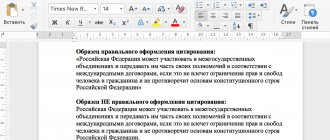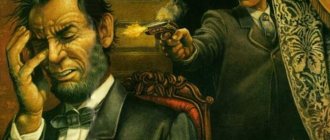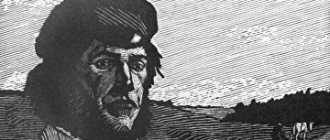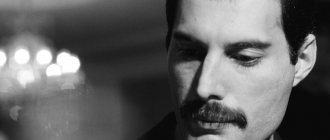Basic rules for quoting and formatting quotes in the text.
For a long time, quotations have been used by people in oral and written speech and serve as a means of confirming or for a broader disclosure of the author’s thoughts. In addition to journalistic works and scientific works, a lot of quotes today can be found on all social networks on user pages.
However, when it comes to inserting a quotation into text, many people face punctuation difficulties. In our article you will find a detailed guide on how to correctly format quotations and insert them into the text, as well as a list of punctuation marks used in the citation process.
How to format citations correctly: basic formatting rules and examples
To format quotes correctly, you need to remember a few basic rules:
- Quotes are phrases or sentences reproduced verbatim by another author that are related in meaning to the content of the text into which they are inserted.
- According to the rules of the Russian language, quotes are highlighted with quotation marks. However, when preparing abstracts and other electronic documents, other selection methods may be used.
- One quotation may contain only one excerpt of a work. If the author plans to quote two or more passages, then they should be formatted as separate quotations.
- In addition, when using quotations, it is necessary to indicate their authors and/or sources.
Example : “People who take all trifles to heart are the most capable of sincere love” (Leo Tolstoy).
Image 1. Definition of a quote and the main ways to format it.
- In cases where the statement of the person you are quoting or the phrase from the source in the original does not begin at the beginning of the sentence, then an ellipsis must be used before the first word in the quotation. Also, all missing words or passages from the original are replaced with ellipses.
Example : Pushkin wrote to his brother Lev: “... we arrived in Kafa and stayed with Bronevsky, a respectable man for his impeccable service and poverty.”
8.2. Using quotation marks
8.2.1. Quotes enclosed in quotation marks
Typed in the same way as basic. The text and the quotes inside it are enclosed in quotation marks to show the boundaries of each - the beginning and the end.
↑ Contents ↑
8.2.2. Quotes not in quotation marks
These are quotes graphically separated from the main ones. text:
1. Highlighted in a font or non-font method (with a font of a different size, design, style; retracted; printed with a paint other than the main text) or if the context makes it clear to the reader that there is a quotation in front of him. For example: Pushkin wrote to his wife: What about my children and my books?
2. Taken from poetic works, preserving the division into poetic lines and typed on a narrower line than the main one. text, format or font lower than the main font. font text. Eg:
Let's remember Pushkin's lines:
The fairy tale is a lie, but there is a hint in it! A lesson to good fellows.
3. Quotes-epigraphs, if they are not accompanied by any non-quoted text.
↑ Contents ↑
8.2.3. Placement of quotation marks
Quotation marks delimiting a quotation are placed only at the beginning and end of it, regardless of the size of the quotation and the number of paragraphs in it.
↑ Contents ↑
8.2.4. Quote drawing
1. Quotations are enclosed in quotation marks of the same design as those used in the main text. text as main ones.
2. If there are words (phrases, phrases) inside the quotation, in turn enclosed in quotation marks, then the latter should be of a different design than the quotation marks that close and open the quotation (external quotation marks are usually Christmas trees “”, internal quotation marks are paws “”).
| Right: | Acceptable: |
| Pushkin wrote to Delvig: “I’m waiting for “Gypsies” and will immediately emboss it.” | “My “Gypsies” are not for sale at all,” Pushkin complained. |
If according to technical For some reason, it is impossible to set quotes from another picture; quotes from one picture are not repeated next to each other. For example, it is incorrect: ““My gypsies are not for sale at all,” Pushkin complained. It is better, however, to highlight quotes in some way by removing the outer quotes, for example, type quotes with a retract and indented paragraphs.
| Note. It is possible to set outer quotes with a different style (for example, bold) or inner quotes with single quotes (□ □). |
3. If the quotation contains quotation marks of the “third stage,” i.e., inside the quoted phrases of the quotation there are, in turn, words taken in quotation marks, the quotation marks of the second picture, i.e., paws, are recommended as the latter.
M. M. Bakhtin wrote: “Trishatov tells the teenager about his love for music and develops the idea of the opera for him: “Listen, do you like music?” I really love... If I were composing an opera, then, you know, I would take the plot from Faust. I really love this topic."
↑ Contents ↑
How to format quotes correctly: highlighting inside quotes
- In order to correctly format quotations, all selections contained in them, according to the rules, must be preserved in their original form. Exceptions are those cases when the author's emphasis does not correspond to the style of the citing publication. Then they are replaced by secretions of a different type.
- In cases where your own highlights or notes have been added to the quotations, they must be indicated. To do this, inside the quotes in brackets you should write your initials and the phrase “ my italics ” or “ emphasis added .” The original author is indicated in parentheses behind the quotation marks.
Example : “Change is always scary. But no one will change your life for you. You understand the choice you must make, but despite the fear, you move forward. This is the main rule of success (emphasis mine. - P.L.)" (Paulo Coelho).
Image 2. Example of a citation with detailed author and source information, down to the page number.
8.3. Paragraphs when quoting
8.3.1. In-quote paragraphs
Preserved as in the source, except when quotations include only a minor part of the text of both paragraphs (for example, the last phrase of one and the beginning phrase of the other).
↑ Contents ↑
8.3.2. Quotes starting with paragraph indentation
This:
1. Quotes of two or more paragraphs.
2. Quotes whose meaning they want to especially emphasize.
3. Quotes that begin the main paragraph. text.
↑ Contents ↑
How to format quotes correctly: punctuation rules
Punctuation when quoting takes place in the 8th grade of high school. But since the topic of punctuation is quite extensive, over time people may forget some rules. To format quotes correctly, let’s consider the main options for placing punctuation marks before and after them:
- In cases where the quotation is preceded by an explanation from the quoter that what follows is a quotation, a colon is placed before the opening quotation marks.
Example : Friedrich Nietzsche once said: “What does not kill us makes us stronger.”
- In cases where inside or after a quotation there is a quotation phrase that introduces the quotation into the text, a period should be placed before the opening quotation marks.
Example: Charles Dickens had a good point about this. “A person cannot truly improve unless he helps others improve,” he emphasized.
- In cases where the quotation is part of a subordinate clause or is used as an addition, then punctuation marks are not placed before the opening quotation marks.
Example : Voltaire once said that “a person must dream in order to see the meaning of life.”
Image 3. Visual table of punctuation for quotations.
- In cases where after a quoted passage from any work there is an exclamation or question mark, as well as an ellipsis, they should be placed inside quotation marks with the quotation. There is no need to put a period after the quotation marks.
Example : Fyodor Mikhailovich Dostoevsky wrote the following lines: “Describing a flower with love for nature embodies civic feelings much more than denouncing bribe-takers...”
- In cases where there is no punctuation mark inside the quotation marks after the quoted phrase, then a period is placed after the closing quotation marks or after indicating the cited source.
Example: Leonardo da Vinci said: “He who strives for the stars does not turn around.”
- In cases where the quoted phrase is part of a subordinate clause, then after the closing quotation marks it is necessary to put a period even when at the end of the phrase inside the quotation marks there are question marks or exclamation marks, as well as an ellipsis.
Example : Arthur Schopenhauer was convinced that “every person can be listened to, but not everyone is worth talking to...”.
8.1. General citation rules
8.1.1. Quote source
It should be the cited publication (work), and not the publication (work) of another author, where the quoted text is given as an excerpt (for an exception, see 8.1.2).
In case of several (many) editions of the cited work, it is recommended to choose a textually authoritative publication as a source (for example, academic collected works), if the purpose of the text does not require quoting another publication (being analyzed, criticized, etc.).
In this case, one should not use an authoritative edition mechanically, but only after making sure first that a textually corrected edition of the cited work has not been published later.
Papr., when quoting “Kholstomer” by L.P. Tolstoy, it is better to choose a non-anniversary Complete book as a source. collection Op. writer, and a later miniature edition of the story (M.: Book, 1979), in which E. G. Babaev, who prepared it, introduced 21 reasonable clarifications in comparison with the text in the Complete volume. collection op., correcting the errors that crept into his text, sometimes rude (“young fellow” instead of “boy”, “bad horses” instead of “quiet horses”, “long” instead of “at home”, “shut up” instead of “laughed”).
↑ Contents ↑
8.1.2. Quote by quote
As a rule, it is prohibited. Permissible as an exception in cases where:
1) the original source is unavailable or difficult to find;
2) a published archival document is quoted, and reproducing the text from an archival source may unlawfully give the citation the character of an archival research;
3) the quoted text became known from the recording of the author's words in the memoirs of another person.
| Note. About the design of bibliogr. For references to the source of the quotation by quotation, see 32.1.3. |
↑ Contents ↑
8.1.3. Basic conditions for semantic accuracy of citation
1. Quoting a logically complete fragment of text, i.e. with completeness that would guarantee the invariance of the meaning conveyed in the source and quotation (without arbitrarily breaking the quoted text, without pulling out words and phrases from the context of the source, when both lead to a change in the meaning or shade of meaning source).
2. For the sake of saving space, discarding words of a quotation that are not necessary for quoting purposes only in the case when this does not affect its meaning.
↑ Contents ↑
8.1.4. Techniques for checking the semantic accuracy of citations
In order to prevent distortions of the thoughts of the quoted author, it is advisable:
1. When checking a quotation with a source, also read the text preceding and/or following it, and compare the meaning of a wide fragment of the text in which the quotation is included with the quotation itself. Eg:
Text with quote:
...the outstanding Soviet director G. A. Tovstonogov makes a very categorical statement: “As soon as words begin to be heard in the theater, modern theater ends.”
Fragment of the source from which the quote is extracted:
Words in modern theater should not be listened to, but entered into our consciousness through action. As soon as words begin to be heard in the theater, modern theater ends. We do not have the right to listen to words separately in the theater and watch actions separately. We must hear and see at the same time.
It is clear that Tovstonogov’s thought is presented distortedly, that the quote is only an incomplete part of the thought formulated by the director, and its essence becomes clear only in context. Having taken a phrase out of it, the quoter attributed to Tovstonogov something that was not in his text, although the literal accuracy of the quotation was observed.
It also happens that the author breaks off the quotation where the words that confirm his point of view end and the words that refute it begin.
For example, the author of the editing manual, to illustrate the words of V. A. Karpinsky that Lenin the editor “limited himself to the minimum of necessary amendments,” cited as an example part of the text from V. A. Karpinsky’s article “Peasant Congress” before and after Lenin's amendments, where only the particle “not” was actually inserted twice.
Meanwhile, the quoted text was followed by Karpinsky’s text, which Lenin crossed out and replaced with his own, and which was three times larger in volume than the quoted text with two supposedly small amendments, but in fact changing the meaning to the exact opposite. So Lenin’s correction in Karpinsky’s article illustrates not the minimality of corrections, but quite the opposite, their large volume. The example was chosen poorly by the quoter, and to make it unnoticeable, he cut off the quote. The editor could notice this only by comparing the quote with a wide fragment of the source, reading there not only the quoted text, but also the text that follows it.
2. Compare the subject of thought in the source with the subject of thought to which the quotation is attributed by the author quoting it, in order to avoid discrepancies between them, which at least devalue the quotation. Eg:
Text with quote:
Scientists believe that correctly orienting eye movements during such long and intense reading as proofreading is far from an easy task. Fortunately, reading skills can be significantly improved even in adults who are perfectly literate. Goethe was not far from the truth when he jokingly complained to Eckermann: “These good people have no idea how much time and labor it takes to learn to read. I have spent eighty years on this and still cannot say that I have achieved my goal.”
Here, the author of the above text used Goethe’s statement about the ability to read as the ability to comprehend the author’s intention as evidence that improving technology. reading skills is never too late. The subject of thought in the source and the quotator differs, and, therefore, the quotation is inappropriate.
3. Check what time the quotation is talking about and whether it is legal to attribute what is said in it to another time, as the quoting person does.
4. Compare the meaning of the quote with the conclusions that the quoting author draws from it in order to check whether these conclusions really follow from the quote. Papr.:
Text with quote:
The information explosion that we are witnessing was presciently foreseen back in 1844 by young Engels. “Science,” he wrote, “moves forward in proportion to the mass of knowledge inherited from previous generations.” In accordance with this formula, every 10-15 years the volume of printed scientific and technical information doubles.
The quoted phrase of Engels in no way follows the conclusion drawn after it by the quoting author. First, just because the volume of information doubles does not mean that the mass of knowledge increases in the same proportion. Secondly, about the period for which the volume of scientific and technical. information doubles, Engels has no speech at all. From Engels' phrase it follows only that science moves forward in proportion to the mass of knowledge it inherits, and nothing more. The mass of knowledge increases and science moves forward in proportion to this. The author's conclusions do not follow from the quotation, and, therefore, either the quotation is inappropriate or the conclusions need clarification.
↑ Contents ↑
8.1.5. Conditions for literal citation accuracy
The quotation must follow the source word for word, letter for letter, punctuation mark for punctuation mark, with some exceptions - see below, 8.1.6 - 8.1.9.
↑ Contents ↑
8.1.6. Spelling and punctuation in quotes
The text of the quotation, as a rule, is given in accordance with the rules and regulations of spelling and punctuation in force at the time of publication. Eg:
| In the source: | In quote: |
| Western European | Western European |
| Exceptions: 1. Keep the ID. features of the author's spelling and punctuation, spelling of words, characteristic of the author's style and era. 2. They do not correct typos and errors in quotations from printed works contemporary to the edition being published by placing a question mark in parentheses after an incorrectly written word (phrase) or a correctly written word (phrase) in straight brackets. Eg: Muravyov himself writes: “You can start out as a pilot, but at the same time know the wake [the fairway!] thoroughly and feel the capabilities of an unfamiliar ship.” |
It is also permissible to correct obvious typos, provided that the correction is specified in the note, but this is advisable to do only in cases where the quoting person needs to comment on an error in the quotation.
↑ Contents ↑
8.1.7. Abbreviations in quotations
Words arbitrarily abbreviated in the source are permitted, as well as words that are abbreviated in the quotation but not abbreviated in the main text. text, write in detail, enclosing the completed parts of words in straight or angular brackets and omitting the period as a sign of abbreviation. Eg:
because]; because]; N.G. Chernyshevsky writes that he “...has established an opinion borrowed from “Domestic Notes”.”.
When quoting documents, angle brackets usually indicate crossed out text, and straight brackets indicate abbreviated words expanded by the quoter.
When abbreviated words are easily understood by the reader, do not cause misunderstandings when reading and do not violate the uniformity of abbreviations in the publication, it is not advisable to expand the abbreviated words. It is undesirable to expand abbreviated words if the abbreviated spelling conveys the peculiarity of the pronunciation of the name, first name and patronymic, etc.
↑ Contents ↑
8.1.8. Banknotes in quotes
You can omit one or more words or even sentences if the thought of the author of the quote is not distorted and if the reader is notified of the bill by an ellipsis in the place of the omitted words and an ellipsis in angle brackets in the place of the omitted sentences. See 8.5.
↑ Contents ↑
8.1.9. Quoting individual words and phrases
When quoting in this way, it is permissible not to put an ellipsis, because it is already clear to the reader that words are omitted before and after the quoted words. Eg:
Pechorin said that “in a vain struggle” he had already “exhausted both the heat of his soul and the constancy of his will”... (Eikhenbaum B.M. About prose. M., 1969. P. 285).
However, the omission of a word within a quoted phrase is indicated by an ellipsis.
↑ Contents ↑
8.1.10. Changing the case of words in a quotation against the original source
Such a deviation from the original source is possible in cases where individual words and phrases are quoted. Eg:
| In the source: | When quoting: |
| I agree with you that the preface is rather boring idle talk... A. S. Pushkin | Pushkin considered the preface “quite boring empty talk.” |
↑ Contents ↑
8.1.11. Addition of signs
In a poetic quotation, typed as prose inside the main. text in the selection with it, a single or double slash or a single or double vertical ruler is introduced to indicate poetic lines at the places where one poetic line ends and another begins.
The punctuation mark before such a sign and the capital letter at the beginning of the line after the sign are retained. Eg:
...Thanks to my involvement in art, the act of poetic creativity... (“With silent triumph on my face // I open the facets of verse...”).
↑ Contents ↑
8.1.12. Emphasis in quotation
When highlighting in a quote:
1. It is advisable to preserve the source selection form. If according to technical reasons, this is impossible, then it is allowed to replace such a form with another, similar in strength, with a reservation once in a note. Eg:
“...In the matter of artistic criticism, Kramskoy is the true Belinsky,” wrote V.V. Stasov (in the source - bold).
2. The highlighting of words by those quoting must be marked or specified in a footnote. For example, the note at the first quote from one source:
* In unspecified cases, italics in quotations are ours. - A.M.
3. It is not necessary to specify the emphasis of words belonging to the author of the quote, except in cases where there are only several authors in quotes from one source. emphases and a lot of emphases from the quoter. Then it is better, more economical, to mark the author. highlighting, and specify the highlighting of the quoting person in the note or apply different forms of highlighting, specifying only the form of highlighting the words by the quoting person. It is preferable, if possible, to have a different form of emphasis by the author and the citing person, indicating this in a note. For example: Quote (italics - the author of the quote, bold - ours).
If the publication can be read inconsistently, it is more appropriate to place all reservations about emphases not in the notes, but at the end of the preface, or on the back of the title. l., after the list of abbreviations, i.e. in a place that the reader probably will not miss.
↑ Contents ↑
8.1.13. Highlighting quotes
It is advisable to highlight multi-line and especially multi-paragraph quotations, since the reader often loses orientation and wastes time trying to figure out whether the quotation has already ended or not.
Form of highlighting quotes: a) retract, if the quote does not exceed a page; b) a retractor with a vertical ruler in it, if the quotation occupies the entire page; c) set in a smaller font size (for example, petit or borges in case) in the cases as in paragraph “b”; d) typing in a font of a different typeface in the same cases as in paragraph “b”.
↑ Contents ↑
How to format quotes correctly: capital and lowercase letters at the beginning of quotes
Image 4: Spelling lowercase letters in quotes.
- To format quotes correctly, you need to know in which cases they begin with a capital letter and in which with a lowercase letter. It all depends on whether the quotation begins at the beginning of the sentence or in the middle. If from the beginning, then the first letter in the quote will be capitalized. If the beginning of the sentence is omitted, then an ellipsis is placed after the opening quotation marks and the first word in the quotation will begin with a lowercase (small) letter.
Example : Omar Khayyam wrote the following lines: “... don’t spit in the well, you’ll drink the water, don’t insult someone of lower rank, and suddenly you have to ask for something. Don’t betray your friends, you won’t replace them, and don’t lose your loved ones, you won’t get them back, don’t lie to yourself, over time you will verify that you are betraying yourself with lies.”
- However, if the quotation is the beginning of a new sentence, it will begin with a capital letter even if you are quoting from the middle of the original sentence.
Example : “... We realize all the good things only with a delay. We live in longing for the past and in fear of the future. Anywhere, but not in the present,” notes Erich Maria Remarque.
Anti-plagiarism. University and citation
Many students complain that despite the quotation marks, anti-plagiarism does not consider these excerpts as quotations. The fact is that the program’s memory stores authoritative sources that are considered acceptable for quoting. And if you copy a downloaded abstract from the Internet, then be prepared for the percentage of the original text to drop.
The shortcoming of anti-plagiarism is that the lion's share of scientific papers and textbooks is ignored by the program, but we hope that its library will be replenished every year.
Are you ready to order a thesis from an experienced author? Then place an order on our service!
Some more nuances of noting quotes
How to indicate a quotation if you only need to quote one word or phrase? In such cases, the given word is enclosed in quotation marks and introduced into the sentence with a small letter:
V. Lakshin emphasized that the faces in Ostrovsky’s comedies are historically accurate and “ethnographically vivid.”
In situations where the original source of the quotation is not freely available (there is no translation into Russian or this is a rare publication), then when quoting you should indicate: “cit. By".
Not only punctuation marks in Russian should serve to convey a quote
For an author writing a scientific or literary work, a quotation is a convincing and economical technique that allows you to present facts to the reader, generalize them and, of course, confirm your idea with reference to authoritative sources.
In non-scientific texts, quotation is often a means of emotional impact. But we must not forget that the passage quoted must be conveyed accurately. Indeed, even in the definition of the concept “quote” it is emphasized that this is a verbatim excerpt from a text. And from this it follows that not only the text itself, but also the punctuation marks that the author has, as well as the emphasis that he has, must be reproduced without distortion.
And this can equally be attributed to both official documents and emotional excerpts from fiction. Only by remembering this can you fully understand what a quote is. An example of respect for the quoted material is, first of all, respect for the author who wrote the lines you quote.
Ways in which quotations are put into context
Quotes can be introduced into a sentence as direct speech. In these cases, punctuation marks in Russian are placed in the same way as when highlighting direct speech.
I. Zakharov emphasizes: “Ranevskaya handed down cruel rulings to others that looked like court decisions. But she didn’t spare herself either.”
In cases where the quote must be separated by the words of the author, it looks like this:
“His Majesty remains completely confident,” wrote A.S. Pushkin A.Kh. Benckendorf, “that you will use your excellent abilities to pass on to posterity the glory of our Fatherland...”
If the quotation is an addition, or it is included in the subordinate part of a complex sentence, then no signs other than quotation marks are placed, and the quotation itself begins with a small letter, even if in the source it was written with a capital letter:
At one time, the philosopher J. Locke said that “there is nothing in the intellect that is not in feeling.”









